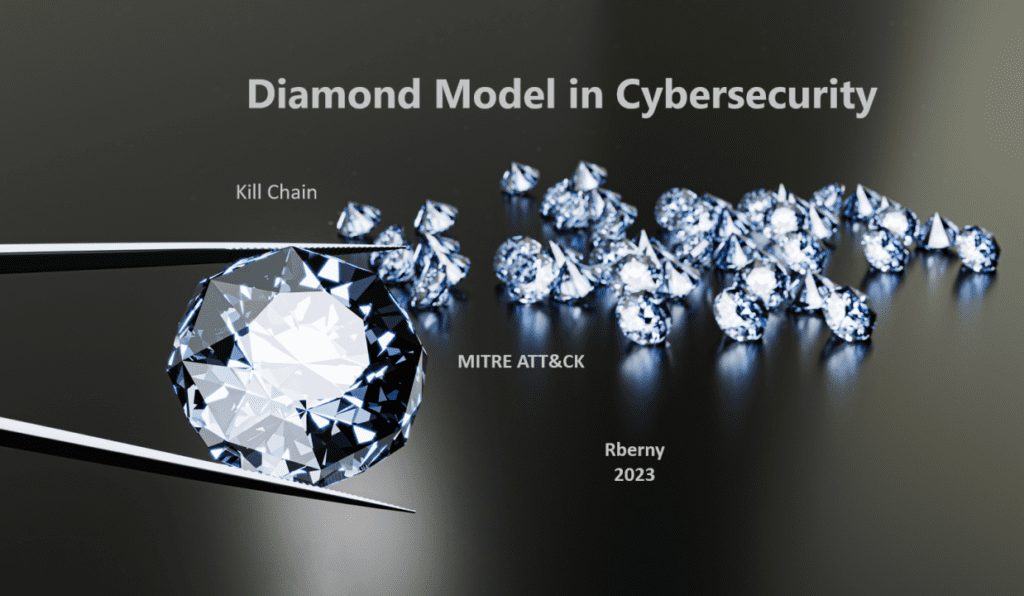Introduction
Welcome to today’s training session on the Diamond Model of Intrusion Analysis. This will be a high-level overview to familiarize you with the concept, but not in-depth enough for direct application in threat intelligence research.
The Diamond Model was developed by the intelligence community, specifically the U.S. government intelligence sector. Though it had likely been in use for some time, it became declassified in 2013. This model aids cyber threat intelligence teams in their research, helping them determine who is responsible for attacks and their motivations.
If you want to dive deeper, refer to the official release document, which provides a comprehensive understanding of the model and its applications.
Understanding the Diamond Model
The Diamond Model consists of four core elements:
- Adversary
- Capabilities
- Infrastructure
- Victim
This model helps analysts understand threats within a network and fill in gaps to determine the relationships between these components.
For example, the adversary develops specific capabilities, which are then deployed through infrastructure, such as a network port, USB stick, or email. The infrastructure then connects to the victim, executing the attack.
By identifying and mapping these connections, analysts can start piecing together how an attack occurred and who might be responsible.
Applying the Diamond Model: Stuxnet Case Study
To better understand the Diamond Model, let’s examine a real-world example—Stuxnet, an attack on Iran’s nuclear enrichment facility.
Breakdown of Stuxnet Attack:
- Adversary: Initially unknown.
- Capabilities: Exploited four different zero-day vulnerabilities.
- Infrastructure: Delivered via USB sticks due to the facility’s air-gapped network.
- Victim: Iranian nuclear enrichment facility.
With these details, analysts can hypothesize who the adversary might be. Given the complexity of the attack—requiring multiple zero-day vulnerabilities against Siemens industrial control systems—the list of possible attackers narrows. Only highly funded intelligence agencies or organizations with deep knowledge of Siemens systems could execute such an attack.
Formulating Hypotheses
Several hypotheses emerged regarding the perpetrators:
- China: Some believed China was behind it, aiming to disrupt India’s space program since India had a satellite using the same Siemens system.
- France (ARA Company): France’s ARA, a competitor of Siemens, had advanced knowledge of Siemens’ systems and might have had motivation.
- United States & Israel: The final determination was that the attack was orchestrated by the U.S. and Israel, as they had the most strategic interest in disrupting Iran’s nuclear program.
Determining the adversary is the hardest part of applying the Diamond Model, often requiring months or even years of analysis.
The Diamond Model and the Cyber Kill Chain
The Cyber Kill Chain, developed by Lockheed Martin, outlines the life cycle of a cyber attack:
- Reconnaissance
- Weaponization
- Delivery
- Exploitation
- Installation
- Command and Control
- Execution
By applying the Diamond Model to each stage of the Kill Chain, analysts can:
- Identify adversaries and their intent.
- Understand how an attack unfolds at each phase.
- Strengthen an organization’s defense by addressing vulnerabilities at different stages.
Conclusion
The Diamond Model is a crucial tool in cyber threat intelligence, helping analysts map out cyber threats and attribute attacks to specific adversaries. While complex in practice, it provides a structured way to analyze cyber threats and can be used alongside frameworks like the Cyber Kill Chain for deeper insights.
Understanding and applying this model can significantly enhance an organization’s ability to defend against sophisticated cyber attacks.
Thank you for reading, and we hope this overview has provided valuable insights into the Diamond Model of Intrusion Analysis!


